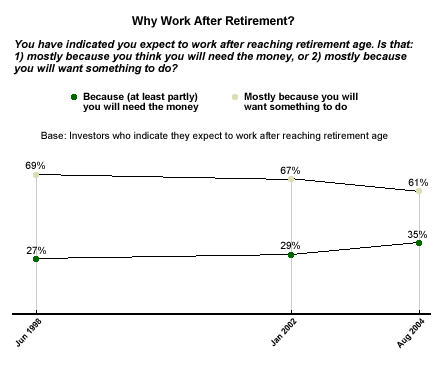First in a series of articles on the UBS/Gallup retirement study
An increasing average life expectancy means that many of today's Americans likely will not only live longer than their parents did, but likely will also retire in better health. As a result, it's not surprising that 89% of U.S. investors who have not yet retired say they intend to do some kind of work after retirement, according to a new UBS/Gallup retirement study*. Perhaps more surprising, however, is that 56% of currently retired investors report that they actually did some work immediately after retiring.
The 2004 investor retirement study -- the third of its kind that Gallup and UBS have conducted -- breaks new ground by including current retirees in the survey sample, allowing a comparison of the expectations of non-retired investors with the reality experienced by investors who have already retired.
Working After Retirement
Three in four investors (74%) who are currently working say they intend to cut back on the time they work after retirement, but plan to remain involved either by doing some consulting or occasional work. In sharp contrast, only about a third (35%) of retired investors say they actually remained involved with their jobs after retiring.
Similarly, nearly half (46%) of non-retired investors expect to continue working in their current job or profession as long as they are physically able. The reality is that only about 3 in 10 retired investors have actually done this.
One of the most popular retirement ideas among working investors today is pursuing a hobby as a way to make money after retirement, but not necessarily with the intent of starting a full-fledged business. But the numbers suggest it may be harder to initiate such a venture than many anticipate: Nearly half (47%) of currently employed investors have such a plan, but only 13% of today's retirees have done so.
Similarly, while 2 in 10 non-retired investors hope to start their own businesses when they retire, only 1 in 10 current retirees have done so. Fifteen percent of working investors plan to look for a new job once they retire, but only 9% of retired investors looked for another job after retiring.

Why Work After Retirement?
The reasons why investors intend to work after retirement have shifted slightly over the three retirement studies Gallup and UBS have conducted. Today, 35% of employed investors say they intend to work after they retire, at least in part, because they will need the money. This percentage is up from 29% two years ago, and 27% in 1998.

Bottom Line
That 9 in 10 investors hope to work after retirement, and a third of those with this desire plan to do so because they will need the money, has enormous implications for the future of the U.S. economy as the baby boomers approach retirement.
If such a large percentage of investors think they'll need to work after retirement, the percentage of U.S. adults overall who will need to continue working will likely be much greater (because non-investors have fewer assets to fall back on in retirement than their investor counterparts do). Many older workers have been displaced over the past several years, while others have lost pension and other retirement benefits. Even if Social Security benefits maintain at today's levels, many future retirees will not have the resources to live as well as their parents did in retirement.
But in today's economy, working after retirement may not even be a viable option for many retirees. Many companies encourage or require their older workers to retire, not only to provide opportunities for younger workers, but also to reduce the wage and benefit costs usually associated with older workers.
The common desire of older Americans to continue working after they retire may turn out to be just as important as the debate over Social Security -- and may become increasingly intertwined with the latter issue -- in the years ahead.
*The special retirement survey is based on a telephone survey of a nationally representative sample of 612 investors who are not retired and of 412 investors who are retired. To be classified as an investor, one must have a minimum of $10,000 in investable assets. All interviewing was completed between July 29-Aug. 1, 2004. For results based on the sample of non-retired investors, the margin of error is ±4 percentage points at the 95% confidence level. For results based on the sample of retired investors, the margin of error is ± 5 percentage points at the 95% confidence level.
